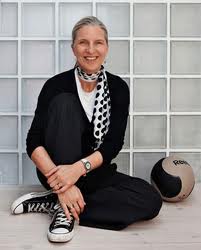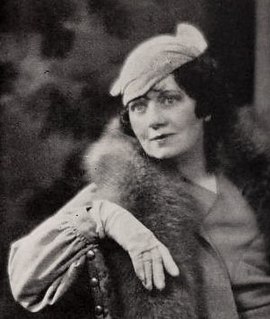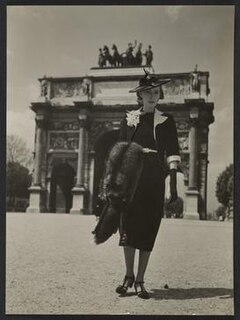Related Research Articles

Fashion is a form of self-expression and autonomy at a particular period and place and in a specific context, of clothing, footwear, lifestyle, accessories, makeup, hairstyle, and body posture. The term implies a look defined by the fashion industry as that which is trending. Everything that is considered fashion is available and popularized by the fashion system.

The Hagley Museum and Library is a nonprofit educational institution in unincorporated New Castle County, Delaware, near Wilmington. Covering more than 235 acres (95 ha) along the banks of the Brandywine Creek, the museum and grounds include the first du Pont family home and garden in the United States, the powder yards, and a 19th-century machine shop. On the hillside below the mansion lies a Renaissance Revival garden, with terraces and statuary, created in the 1920s by Louise Evelina du Pont Crowninshield (1877–1958).

A department store is a retail establishment offering a wide range of consumer goods in different areas of the store, each area ("department") specializing in a product category. In modern major cities, the department store made a dramatic appearance in the middle of the 19th century, and permanently reshaped shopping habits, and the definition of service and luxury. Similar developments were under way in London, in Paris and in New York (Stewart's).

The economy of England is the largest economy of the four countries of the United Kingdom.

Stephanie Louise Kwolek was a Polish-American chemist who is known for inventing Kevlar. Her career at the DuPont company spanned more than 40 years. She discovered the first of a family of synthetic fibers of exceptional strength and stiffness: poly-paraphenylene terephthalamide.
Eugene Shallcross Ferguson was an American engineer, historian of technology and professor of history at the University of Delaware, particularly known for his 1992 work Engineering and the Mind's Eye.

Sir David Charles Clary, FRS is a British theoretical chemist. He was president of Magdalen College, Oxford, from 2005 to 2020. He was the first chief scientific adviser to the Foreign and Commonwealth Office from 2009 to 2013. He is a Professor of Chemistry at the University of Oxford.

Trade literature is a general term including advertising, customer technical communications, and catalogues.
David Allen Hounshell is an American academic. He is the David M. Roderick Professor of Technology and Social Change in the Department of Social and Decision Sciences, Department of History, and the Department of Engineering and Public Policy at Carnegie Mellon University. He is known for his work of the history of research and development and industrial research in the United States, particularly at DuPont.

Anne Lise Kjaer is a London-based futurist and keynote speaker. Also known as a Future Narrator, her specialty is futures studies and consumer mindsets. She is founder of Kjaer Global, a trend forecasting agency that works with corporations, including Sony, Nokia, Swarovski, IKEA, Gap and Toyota. In a 2004 interview about mapping future trends, Matthew Temple of the Financial Times said: “Kjaer’s world is as fertile as Dali’s, only she creates social prototypes.”
Richard A. Williams OBE FREng FTSE, FRSE is a British academic and engineer. He is the Principal and Vice-Chancellor of Heriot-Watt University. He took up this position on 1 September 2015. He is a chemical engineer. He was Vice President and a Trustee of the Royal Academy of Engineering.
Fashion forecasting is a global career that focuses on upcoming trends. A fashion forecaster predicts the colors, fabrics, textures, materials, prints, graphics, beauty/grooming, accessories, footwear, street style, and other styles that will be presented on the runway and in the stores for the upcoming seasons. The concept applies to not one, but all levels of the fashion industry including haute couture, ready-to-wear, mass market, and street wear. Fashion trend forecasting is an overall process that focuses on other industries such as automobiles, medicine, food and beverages, literature, and home furnishings. Fashion forecasters are responsible for attracting consumers and helping retail businesses and designers sell their brands. Today, fashion industry workers rely on the Internet to retrieve information on new looks, colors, celebrity wardrobes, and designer collections.
Evelyn Kathleen Welch is an American-English scholar of the Renaissance and Early Modern Period, and Vice Chancellor of the University of Bristol. Prior to her role as Vice Chancellor, Evelyn was the professor of Renaissance Studies, Provost, and Senior Vice President at King’s College London. She served as the Interim President and Principal of King's College London from February to June 2021.

Edward Leroy Loper Sr. was an African American artist and teacher from Delaware, best known for his vibrant palette and juxtaposition of colors. He taught painting for almost 70 years.
Corriere delle dame was a weekly Italian language fashion magazine published in Milan, Italy, between 1804 and July 1875. The magazine is one of the pioneers in women's emancipation in Italy.

Robert W. Cairns (1909-1985) was an American chemist who worked at Hercules and at the U.S. Department of Commerce. He contributed to World War II technological advances in explosives.
Azuline is a coal-tar blue dye that became popular for colouring silk in 1861. It was one of the first synthetic dyes. The name was a combination of "azure" and "aniline". A variant of the name was "Azurine". The word was introduced as a colour term about the same time as "mauve" and "magenta", but it has not survived in the English language.

Paul Lorin Bechly is an American chemical engineer known for his work in the development of an environmentally-oriented perfluorocarbon gas policy for DuPont and other industries. He currently works in the financial industry.

Margaret Hayden Rorke was an American color standards expert, actress, and suffragist who was for nearly 40 years the managing director of the Textile Color Card Association of the United States. She is known as "the most influential 'color forecaster' of the 1920s and 30s."

Bettina Bedwell was an American journalist and fashion illustrator. She reported on fashion from Paris throughout the 1920s and 30s.
References
- ↑ Testa, Jessica (2019-12-04). "Pantone Declares Another Year of Blue". The New York Times. Retrieved 2020-11-01.
- ↑ Binkley, Christina (2012-12-06). "A Year in the Emerald City". The Wall Street Journal. Retrieved 2020-11-10.
- ↑ Petrovich, Dushko (2013-03-17). "Munsell, the man who colored America". The Boston Globe. Retrieved 2020-11-10.
- ↑ Falconer, Bruce (2018-11-28). "What Is the Perfect Color Worth?". The New York Times. Retrieved 2020-11-10.